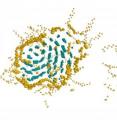What your candles and TV screen have in common
Related images
(click to enlarge)
The next time you light a candle and switch on your television ready for a relaxing evening at home, just think. These two vastly different products have much more in common than you might imagine. Research recently carried out by Prof Tanja Schilling and associates, Muhammad Anwar and Francesco Turci, at the Physics and Material Science Research Unit of the University of Luxembourg made this surprising connection, which works as follows.
In the process of refining crude oil, paraffin wax is produced as a by-product. Paraffin wax is widely used in many ways -- candles, lubricants, paint, medicines and even many of our best loved beauty products.
The crystallisation process of paraffin has been widely studied on a macroscopic level, but very little has been known on the microscopic level -- until now. Prof Schilling and her colleagues made a study of paraffin at the individual molecular level and examined the process by which molten wax crystallises, with startling results.
They found that wax molecules align in a similar way to molecules in liquid crystal before they slide into their final positions and that this closely resembles the processes that are used in liquid crystal display (LCD) technology, like your television screen.
"This research will be of value to the plastics industry as the polymers which make up plastics are long-chain versions of the molecules in wax," says Prof Schilling.
Almost every plastic product we use each day is created via the injection moulding process. This a method whereby molten plastic is injected into a mould and cooled to form the product required. Prof Schilling's research adds important knowledge as to how to control any potential defects in this process.
Source: Université du Luxembourg
Other sources
- Physics research: What your candles and TV screen have in commonfrom Science DailyTue, 14 Jan 2014, 16:30:22 UTC
- What your candles and TV screen have in commonfrom PhysorgTue, 14 Jan 2014, 14:31:16 UTC
